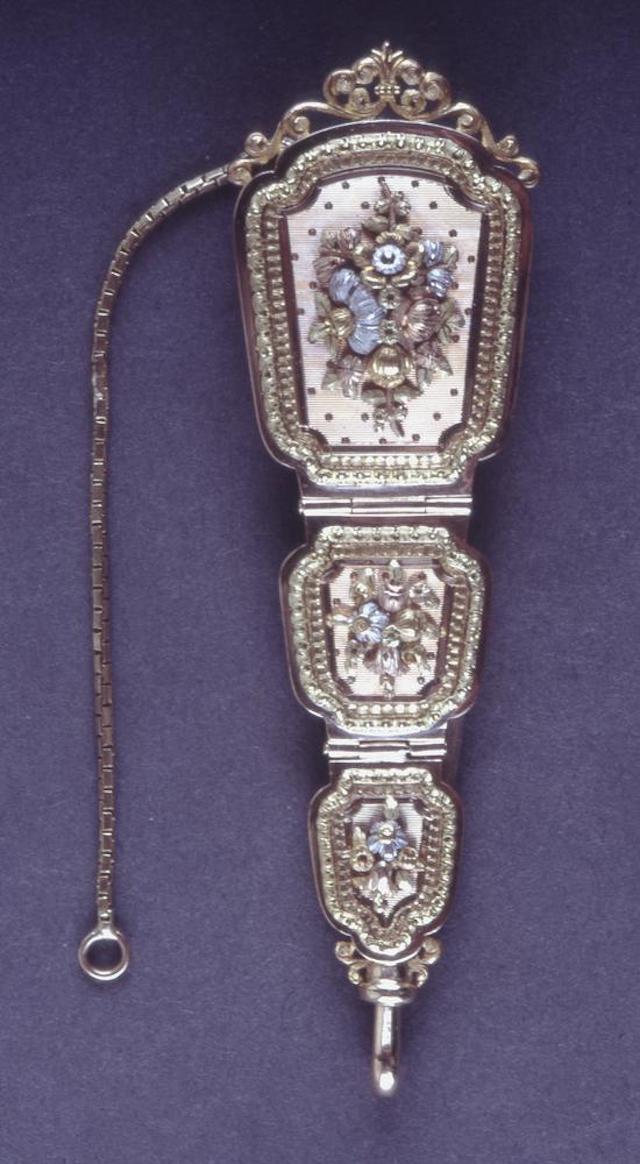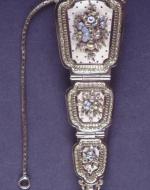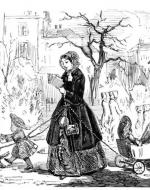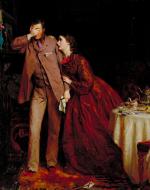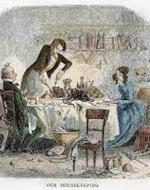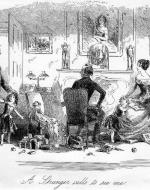Created by Emma Stratman on Tue, 11/02/2021 - 11:18
Description:
The Victorian ideal of the "Angel in the House" comes from Coventry Patmore's popular poem by the same name (1854-62). A dedication to his wife, the poem praises a woman who is charming, graceful, sympathetic, self-sacrificing, and capable. Patmore fixes the idealized theme of Victorian womanhood, presenting these virtues as the feminine mission. But a woman's work is not solely to please her husband--- she does all of this because she wants to. She embraces the Victorian ideal and finds fulfillment through it. The chatelaine is the ultimate tool of the Victorian Angel, and Charles Dickens appreciates both this object and the ideal it represents in his presentation of womanhood in David Copperfield (1850). The chatelaine and the domestic responsibilities it represents act as a metric for evaluating the respective roles of Clara Copperfield, Dora Copperfield, and Agnes Wickfield in David Copperfield as the women in David's life strive to fulfill the mission of Angelhood outlined by Patmore, but perpetuated by Victorian society.
Bouquet Engraved Gold Chatelain, British Museum, Circa 1880.
The chatelaine is a small fixture that women in the Victorian era fastened to their waist or belt, allowing household items such as keys, pencils, scissors, or button hooks to be easily accessible, as Victorian dresses typically did not have pockets. The chatelaine became representative of running a household, a physical manifestation of the domestic responsibility Victorian women bore. As Clara Copperfield begins her decline, meek and incapable in the eyes of David’s stepfamily, the cruel Murdstones, she has her chatelaine and keys taken away. Miss Murdstone tells Clara, “‘You’re much too pretty and thoughtless... to have any duties imposed upon you that can be undertaken by me. If you’ll be so good as give me your keys, my dear, I’ll attend to all this sort of thing in future’" (Chapter 4). Dickens presents Clara as beautiful and affectionate, but weak-willed and impressionable, marking her as ultimately unqualified for the keys of the house and the responsibility they require. In losing her keys, Clara loses her purpose as a homemaker, wife, and mother. In contrast, sweet Agnes Wickfield has been the bearer of the keys since the first time David lays eyes upon her: "She had a little basket trifle hanging at her side, with keys in it; and she looked as staid and discreet a housekeeper as the old house could have. She listened to her father as he told her about me with a pleasant little face…” (Chapter 15). Even when she and David are very young, Agnes is characterized as a capable caretaker. Agnes has an innate grace and understanding about her which allows her to anticipate the needs of the men in her life and alleviate their struggles, all while maintaining a perfect home. These abilities mark her as a true angel in the house.
John Leech, "How To Make A Chatelaine a Real Blessing to Mothers," Pictures of Life and Character from the Collection of Mr. Punch, 1886.
Leech’s engraving exaggerates the function of the chatelaine, but not its importance. The 1886 engraving depicts a mother with a chatelaine attached to her dress. Instead of keys, her children are attached to the chains, symbolizing the significance of the chatelaine to the Victorian wife and mother in the domestic sphere. The chatelaine is representative of a woman's responsibility throughout the phases of life, as clearly caricatured in Leech’s image. The popular perception of the chatelaine that this illustrates further emphasizes the magnitude of Clara’s loss when Miss Murdstone confiscates her keys. Raising children was a major facet of Victorian womanhood, and though the children in this engraving pull the mother in all directions, it is the chains of the chatelaine that allow her to maintain control and stability.
George Elgar Hicks, Woman's Mission: Companion of Manhood, 1863.
In his triptych, George Elgar Hicks illustrates the duties of the Victorian woman, and defines her by the phases of nurturing and caring for the men in her life. The full triptych illustrates a mother guiding and nurturing her son, consoling her husband, and finally caring for her father in his old age. The second piece in the series, titled Companion of Manhood, is deeply reminiscent of Charles Dickens's presentation of David's second marriage to Agnes Wickfield in David Copperfield. In Companion of Manhood, the husband has just received a notice of death, as evidenced by the black-trimmed envelope. As he covers his face in mourning, his lovely (but not frivolous) wife embraces him, comforting him in his mourning. Besides this clear demonstration of affection, the wife supports her husband by maintaining a well-run home. A fresh flower adorns the well-kept mantel, and carefully made tea sits upon the table. This is reminiscent of Agnes’s domestic capabilities. After recovering her father’s property from Uriah Heep, Agnes is able to return the home to the state it was in David’s youth: “The books that Agnes and I had read together, were on their shelves; and the desk where I had laboured at my lessons, many a night, stood yet at the same old corner of the table. All the little changes that had crept in when the Heeps were there, were changed again. Everything was as it used to be, in the happy time” (Chapter 60). Much like the subject of Companion of Manhood, as David mourns the loss of his “child-wife” Dora, he is comforted by Agnes’s ability to run a home, and her thoughtfulness in returning him to the happiest times of his childhood.
Hablot Knight Browne (Phiz), "Our Housekeeping," in Charles Dickens's David Copperfield, 1850.
This colorized illustration of Phiz’s “Our Housekeeping” is the ultimate depiction of Dora’s shortcomings in the domestic sphere. As the newlywed Copperfields host Traddles for dinner, the house is in a clear state of disarray with books, instruments, and even furniture strewn about. This illustration of Dora’s housekeeping stands in stark contrast to Dickens’s description of the comforting and carefully maintained Wickfield residence. David struggles to carve the mutton, Jip the dog lays before Traddles on the table, and the pile of oysters sits in front of Dora, unable to be enjoyed because she neglects to open them before cooking the meal. This state of disorder is indeed a source of stress for David, as he feels he must teach Dora how to maintain a home. In contrast, Agnes, perpetually with her jingling keys by her side, has always been a capable homemaker: “Even when she was quite a child, she was the Agnes whom we know” (Chapter 44). In his comparison of Agnes and Dora, Dickens highlights the importance of domestic responsibility in the ideal Victorian woman. The maintainence of the home is not significant solely because of the physical environment, but because of the emotional impact it has on the man of the house. The spaces that Dora and Agnes respectively cultivate are physical representations of what they are able to provide for David. In his home with Dora, David feels no peace of mind, and must himself “[bear] the weight of all [their] little cares” (Chapter 48). In turn, in the Wickfield residence David notes “how different [he] felt in one short minute, having Agnes at [his] side!” (Chapter 35), and in marrying Agnes, he forever has her angelic comfort.
Hablot Knight Browne (Phiz), "A Stranger Calls to See Me," in Charles Dickens's David Copperfield, 1850.
Dickens’s comparison of Agnes to an angel is at its most explicit in this final image of the Copperfield family and their visitor, the kind old Mr. Pegotty. Agnes sits fully illuminated in the light, with two angel figurines situated on the mantel overhead. She welcomes their old friend as a doting child leans affectionately on her lap. Dickens does not hesitate to compare Agnes to Patmore’s Angel, or to a true heavenly figure, writing that “Agnes—... the better angel of the lives of all who come within her calm, good, self-denying influence—is quite a woman” (Chapter 18). Religious and angelic imagery surrounds Agnes, effectively establishing her as the pinnacle of womanhood, a figure for all other female characters to look up to. While David mourns the loss of Dora, Agnes offers him “words of hope and peace, her gentle face bending down as from a purer region nearer Heaven” (Chapter 54). This idealization raises Agnes to a state of holiness: “...a soft light of the coloured window in the church, seen long ago, falls on her always...and on everything around” (Chapter 16).

